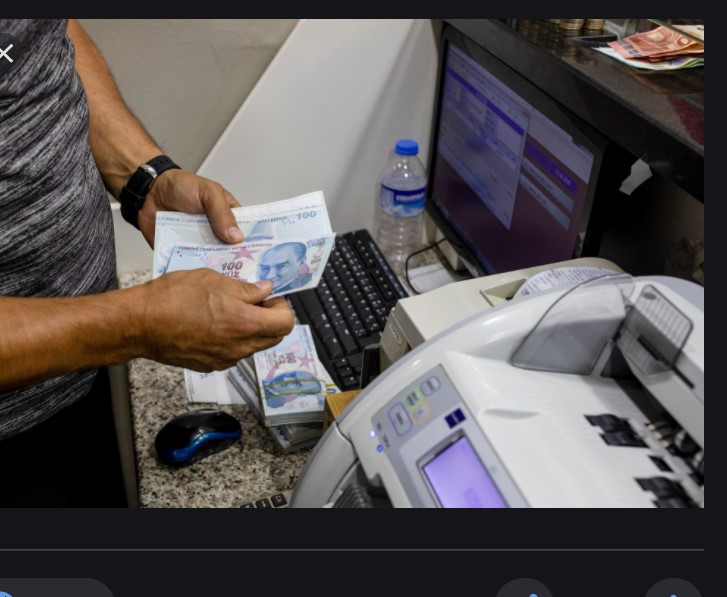Turkey’s lira fell to a six-month low on Thursday as risks of tighter U.S. monetary policy after strong inflation data weighed on most emerging market assets, with stocks set for their worst day since late March.
The lira fell around 0.8% to 8.4968 against the dollar, just a few points shy of its 8.5789 record low. The currency was likely subject to offshore selling on Thursday, given that Turkish markets were closed for a holiday.
Recent losses in the lira have brought the focus back to Turkey’s shrinking foreign exchange reserves, as well as its central bank, which is hesitant to tighten policy even as inflation surges.
Diego Cupolo, the resident Turkey expert at al Monitor, covered the reasons for the new and sudden decline in the Turkish currency. These reasons go beyond the Eid al Fitr holiday, and the turbulence in EM, his contacts argue:
A rolling decline in Turkey’s lira accelerated Thursday as the currency slid to a six-month low after US inflation data put pressure on most emerging markets.
WATCH: Turkey on the Verge of Currency Crisis | Real Turkey
With low foreign exchange reserves and a Central Bank hesitant to tighten monetary policy amid double-digit inflation, Turkey’s economy remains highly vulnerable to global market trends.
The latest tremor comes after US consumer prices jumped to 4.2% Wednesday, up from 2.6% in March, its steepest rise since 2008. The figures raised expectations the US Federal Reserve will tighten its monetary policy sooner than expected, sending most emerging market currencies down Thursday, with the Turkish lira leading the cohort.
“The lira has depreciated more than other emerging market currency by the upside surprise to US inflation and the subsequent rise in US bond yields,” Ugras Ulku, head of European emerging markets research at the Institute of International Finance (IIF), told Al-Monitor. “This, in part, reflects the fact that Turkish markets are closed due to the Ramadan holiday and the current level of the lira exchange rate is based on relatively thin trading volumes.”
Since the shocking appointment of Turkish Central Bank Governor Sahap Kavcioglu in late March, the lira has lost about 13% of its value against the dollar. As Turkey’s fourth Central Bank governor since 2018, Kavcioglu took the helm on expectations he would cut the nation’s benchmark interest rate, but has so far maintained a 19% rate set by his predecessor as a weak lira coupled with 17.14% annual inflation in April have restricted his options.
WATCH: Turkish Politics Is Changing Rapidly | Real Turkey
Selva Demiralp, an economics professor at Koc University and director of the Koc University-TUSIAD Economic Research Forum, said expected rate cuts under Kavcioglu, who had previously criticized high interest rates, remain the main trigger for the depreciation of the Turkish lira.
“Market response to an anticipated rate cut most likely prevented the [bank] from actually cutting the rates,” Demiralp told Al-Monitor. “Even though they haven’t considered a rate cut, they are not able to convey a strong and credible message about maintaining a hawkish stance, either, which is the reason for the weak lira.”
Gizem Oztok Altinsac, chief economist at TUSIAD, said Turkey’s Central Bank would have little room for an interest rate cut anytime soon in a Thursday article for Yetkin Report. Citing Turkey’s week macroeconomic outlook and high external financing needs, Altinsac argued monetary policy-makers would need to adhere to prudent measures under ongoing inflationary pressures.
The Mitsubishi UFJ Financial Group also pushed back its expectations Monday for monetary-policy easing in Turkey, predicting such moves would begin the year’s third quarter instead of the second quarter.
The developments come after Wells Fargo published a report Tuesday ranking Turkey among the nations most vulnerable to an external debt crisis in the near term. The news follows an IIF report last week in which the institute revised its fair value estimate for the Turkish lira to 9.5 per dollar, up from 7.5 in June 2020.
The change was driven by steep declines in market sentiments toward the Turkish economy since Kavcioglu’s appointment in late March. Ulku, who co-authored the report, said the IIF lifted its estimate because Turkey’s current account deficit “is looking a bit wider than we had assumed earlier this year, and capital flows look a lot weaker.”
“That balance suggests to us that the equilibrium fair value has shifted, and within our fair value assessment framework we get a roughly 10% overvaluation for the lira in real effective terms,” Ulku told Al-Monitor.
Follow our English language YouTube videos @ REAL TURKEY: https://www.youtube.com/channel/UCKpFJB4GFiNkhmpVZQ_d9Rg
And content at Twitter: @AtillaEng
Facebook: Real Turkey Channel: https://www.facebook.com/realturkeychannel/
